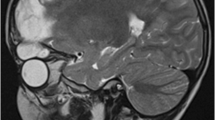Abstract
Nonshaved neurosurgery, cranial or spinal, is well reported among Caucasians but hardly among native Africans. The ungroomed scalp hairs of black Africans have unique anthropological characteristics needing special attention for shaveless cranial surgery. A technical report of the execution of this surgical procedure among an indigenous patient population in a sub-Sahara African country is presented, as well as an outcome analysis in a prospective cohort over a 7-year period. A total of 303 patients (211 males, 70 %) fulfilled the criteria for this study. The surgical procedure was primary in 278 (92 %) and redo in 8 %. It was emergency surgery in 153 (51 %). They were trauma craniotomies or decompressive craniectomies in 95 cases (31 %), craniotomies for tumour resections in 86 (28 %), and the surgical dissections for other conditions in 122 (41 %). The duration of surgery ranged from 30 min to 8.5 h, mean 2.5 (SD, 1.6), median 2. In-hospital clinical outcome was good (normal status or moderate deficit on dichotomized Glasgow outcome scale (GOS)) in 273 (90.1 %) cases while surgical site infections occurred in only 10 cases (3.3 %). The type of surgery, redo or primary, did not have any significant association with the in-hospital outcome (p = 0.5), nor with the presence of surgical site infection (SSI) (p = 0.7). The length of follow-up ranged from 2 to 63 months (mean, 7) with no untoward complications reported so far. Medium-term outcome of nonshaved neurosurgery in this indigenous black Africans remains favourable with no attendant significant adverse after-effects.




Similar content being viewed by others
References
Abouzari M, Sodagari N, Hasibi M, Behzadi M, Rashidi A (2009) Re: Nonshaved cranial surgery in black Africans: a short-term prospective preliminary study (Adeleye and Olowookere, Surg Neurol 2008;69–72) Effect of hair on surgical wound infection after cranial surgery: a 3-armed randomized clinical trial. Surg Neurol 71:261–262, author reply 262
Adeleye AO, Olowookere KG (2008) Nonshaved cranial surgery in black Africans: a short-term prospective preliminary study. Surg Neurol 69:69–72, discussion 72
Adeleye A, Ukachukwu A (2014) The simple urine bag as wound drain post-craniotomy in a low-resource neurosurgical practice: a personal 4-year prospective cohort study. East Cent Afr J Surg 19:67–72
Beldi G, Bisch-Knaden S, Banz V, Muhlemann K, Candinas D (2009) Impact of intraoperative behavior on surgical site infections. Am J Surg 198:157–162
Bhatti MI, Leach PA (2013) The incidence of infection for adults undergoing supra-tentorial craniotomy for tumours without hair removal. Br J Neurosurg 27:218–220
Braun V, Richter HP (1995) Shaving the hair—is it always necessary for cranial neurosurgical procedures? Acta Neurochir 135:84–86
Broekman ML, van Beijnum J, Peul WC, Regli L (2011) Neurosurgery and shaving: what’s the evidence? J Neurosurg 115:670–678
Celik SE, Kara A (2007) Does shaving the incision site increase the infection rate after spinal surgery? Spine 32:1575–1577
Franbourg A, Hallegot P, Baltenneck F, Toutain C, Leroy F (2003) Current research on ethnic hair. J Am Acad Dermatol 48:S115–S119
Gil Z, Cohen JT, Spektor S, Fliss DM (2003) The role of hair shaving in skull base surgery. Otolaryngol Head Neck Surg: Off J Am Acad Otolaryngol Head Neck Surg 128:43–47
Howell JM, Morgan JA (1988) Scalp laceration repair without prior hair removal. Am J Emerg Med 6:7–10
Hrdy D (1973) Quantitative hair form variation in seven populations. Am J Phys Anthropol 39:7–17
Hwang SC, Kim SK, Park KW, Im SB, Shin WH, Kim BT (2012) Outpatient-based scalp surgery without shaving and allowing use of shampoo. World Neurosurg 77:391–393
Kumar K, Thomas J, Chan C (2002) Cosmesis in neurosurgery: is the bald head necessary to avoid postoperative infection? Ann Acad Med Singap 31:150–154
McMichael AJ (2007) Hair breakage in normal and weathered hair: focus on the black patient. J Investig Dermatol Symp Proc 12:6–9
Porter CE, Diridollou S, Holloway Barbosa V (2005) The influence of African-American hair’s curl pattern on its mechanical properties. Int J Dermatol 44(Suppl 1):4–5
Porter CE, Dixon F, Khine CC, Pistorio B, Bryant H, de la Mettrie R (2009) The behavior of hair from different countries. J Cosmet Sci 60:97–109
Sebastian S (2012) Does preoperative scalp shaving result in fewer postoperative wound infections when compared with no scalp shaving? A systematic review. J Neurosci Nurs: J Am Assoc Neurosci Nurs 44:149–156
Siddique MS, Matai V, Sutcliffe JC (1998) The preoperative skin shave in neurosurgery: is it justified? Br J Neurosurg 12:131–135
Tokimura H, Tajitsu K, Tsuchiya M, Yamahata H, Taniguchi A, Takayama K, Kaji M, Hirabaru M, Hirayama T, Shinsato T, Arita K (2009) Cranial surgery without head shaving. J Craniomaxillofac Surg: Off Publ Eur Assoc Craniomaxillofac Surg 37:477–480
Winston KR (1992) Hair and neurosurgery. Neurosurgery 31:320–329
Wolfram LJ (2003) Human hair: a unique physicochemical composite. J Am Acad Dermatol 48:S106–S114
Author information
Authors and Affiliations
Corresponding author
Ethics declarations
Conflict of interest
The author declares that he has no competing interests.
Rights and permissions
About this article
Cite this article
Adeleye, A.O. Nonshaved cranial surgery in black Africans: technical report and a medium-term prospective outcome study. Neurosurg Rev 39, 449–454 (2016). https://doi.org/10.1007/s10143-016-0700-4
Received:
Accepted:
Published:
Issue Date:
DOI: https://doi.org/10.1007/s10143-016-0700-4




